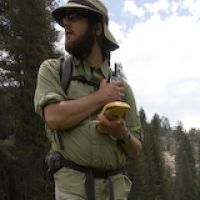Conklin & Lucas, 2010
Spatial and temporal variations of evapotranspiration signals in Long Meadow, Sequioa National Park, California.
Conklin, M.H., Lucas, R.G. (2010)
Fall meeting, American Geophysical Union, December 2010. Abstract H32C-03.
-
Sierra, INVESTIGATOR
-
Sierra, GRAD STUDENT
Abstract
Montane meadows are often locations of groundwater discharge, with their hydrologic fluxes reflecting watershed processes. We analyzed continuously recorded groundwater levels in ten monitoring wells in three transects from the meadow edge to the meadow center for water years 2008-2010 to estimate daily evapotranspiration (ET) rates. Long Meadow, part of the Southern Sierra Critical Zone Observatory, is located at an elevation of 2230 m, is approximately 1.5 km in length and is up to 250 m wide; a 730-ha snow-dominated catchment drains into the meadow. The meadow lies in a glaciated valley over alluvium as thick as 30 m. A stream runs intermittently in both time and space down the meadow from south to north. ET rates from meadow monitoring wells provide 15-minute data that are vital for establishing a water balance for the meadow. Well-derived ET rates vary in space, from the meadow/forest boundary to the meadow stream, and time diurnally, seasonally and inter-annually. Spatially varying but strong ET signals (5-10 mm/d) come from the meadow vegetation, on the meadow slope and/or from the adjacent forested hillslopes of the watershed. ET signals near the meadow stream are muted (2-5 mm/d), but relatively constant over time. Muting is attributed to meadow grasses using surface water for ET. Temporal ET trends depend on timing of snowmelt, phenology of the meadow vegetation, and by the magnitude of winter precipitation in the watershed. Chamber measurements, taken during the same period, match ET signals on the meadow slopes during the peak of the vegetation growing season (June to August). Vegetation in the meadow senesces in the late summer/early fall, however, wells located near the meadow/forest boundary continue to exhibit significant ET signals well into the fall, after senescence. Diurnal fluctuations in water-level monitoring wells installed in the sap-rock complex outside the meadow boundary identify the meadow-watershed connection.
Citation
Conklin, M.H., Lucas, R.G. (2010): Spatial and temporal variations of evapotranspiration signals in Long Meadow, Sequioa National Park, California . Fall meeting, American Geophysical Union, December 2010. Abstract H32C-03. .
Explore Further


